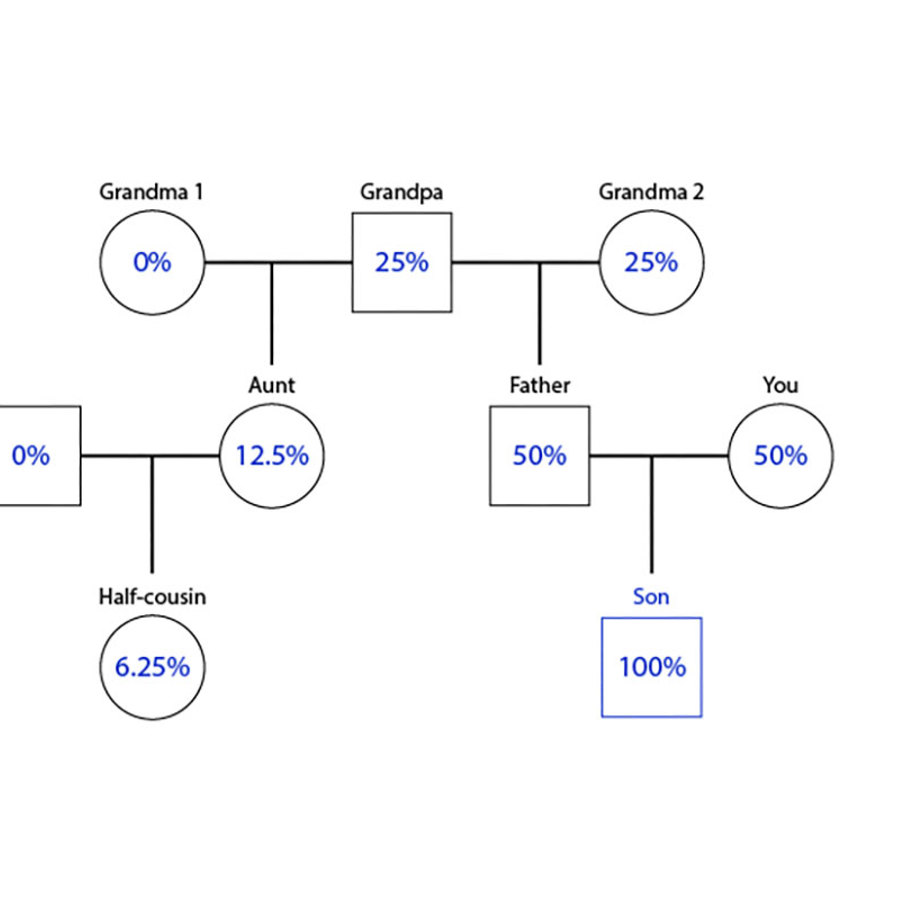
How is someone related to the child of their parent’s half-sibling?
January 9, 2014

- Related Topics:
- Genetic genealogy,
- Relatedness
A curious adult from Florida asks:
“My son’s father has a half-sister. She has a daughter. How are the son and daughter related?”
The short answer is that these two are half-cousins, and share about 6.25% of their DNA.
Every kid gets half of their DNA from their mom and half from their dad. But as you’ll see below, each kid doesn’t usually get the same 50% from each parent. In fact, two siblings usually share 25% of their mom’s DNA and 25% of their dad’s DNA.
If you add that up, you see that full siblings usually share a total of 50% of their DNA. You can use this same pattern to figure out DNA sharing between all relatives.
I said ‘usually’ and ‘about’ because siblings share, on average, 50% of their DNA. Hypothetically, they can share any amount from 0-100%! Click here to learn more about this.
Let’s briefly go over how much one person is likely related to some of their relatives. In the table below, the numbers indicate how much DNA you share with some of your relatives:
|
Relatives |
Percent DNA you share |
|
Parents, siblings, children |
50% |
|
Nieces, nephews, aunts, uncles, grandparents |
25% |
|
First cousins, great-grandparents, great-uncles, great-aunts, grand-nieces, grand-nephews |
12.5% |
|
First cousins once removed, half cousins |
6.25% |
|
First cousins twice removed, second cousins |
3.125% |
OK, so that is a lot of numbers. For the rest of the answer, I’m going to just focus on your situation and go through the details of why your son and his half cousin share around 6.25% of their DNA.
Making a Family Tree
It is easy to get lost in the details of family history. A simple way to deal with this is to make a family tree. Here is what yours might look like:


In a family tree, the squares are men and boys and the circles are women and girls. The horizontal lines mean the two people had children, who are shown at the end of vertical lines.
As you can see, the nearest shared relative between your son and his cousin is their grandfather. (Everything in this answer would also work if they were related through a grandmother.)
Now as I said earlier, each parent shares 50% of their DNA with their kids. This means that your son’s father and his half-sister each got 50% of their DNA from grandpa.
Here is the same family tree with the percent of DNA each relative shares with your son:


So far we have been dealing with theoretical numbers. What I want to do next is focus in on what is actually going on when the DNA is passed down.
How DNA is Inherited
Let’s start out by taking a look at the DNA from the grandpa in this family tree. Here’s what his DNA might look like:


Our DNA comes in the form of chromosomes. Each rectangle here represents a chromosome and as you can see, humans typically have 46 of them.
Notice that Grandpa actually has pairs of chromosomes: 23 pairs, in fact. In these pictures I have colored one chromosome in each pair green and the other blue.
Each parent gives one chromosome from each of the 23 pairs to one of their kids. So for Grandpa, the green chromosomes came from his mom and the blue ones came from his dad.
Now let’s add in the two different grandmas. We won’t color their DNA because we just want to focus on the shared DNA. Only the DNA from Grandpa is shared between your son and his cousin. Here is what the grandmas’ DNA looks like:


When parents give one of their chromosomes from each pair to their kids, it’s random. For example, when Grandpa gives DNA to his son, for each pair, the son could get a blue or a green chromosome. Basically, genetics flips a coin over each chromosome pair when parents pass DNA to their kids.
Grandpa is going to pass along 23 chromosomes (one from each pair) to his son. He also passes along 23 chromosomes to his daughter. But they are not necessarily the same ones …
There is a tiny chance that all of Grandpa’s DNA might get passed down like this:


In this case, both the son and daughter got only blue chromosomes from Grandpa. They would be 50% related.
It is also possible that all of Grandpa’s DNA gets passed down this way:


In this case, the son got only green chromosomes and the daughter got only blue chromosomes from grandpa. Now they aren’t genetically related at all!
Neither of these cases is very likely. Almost always you get a result like this:


As you can see, the son and daughter end up sharing around half of the grandpa’s blue and green chromosomes. So the son and daughter are about 25% related.
If this is all there was to passing down DNA, each half sibling would have around a 1 in 8 million chance of not being related at all. That’s a really small chance, but it would happen every now and then. But, it almost certainly never does!
Why? Because real life is more complicated than this. In real life, chromosomes in each pair mix together before being passed along to kids. This evens out the possible amounts of DNA shared by relatives.
If you want more details, click here. But we don’t have to go into that much detail here. We just need to know that, in general, half siblings will be about 25% related.
Now, let’s consider the kids of half siblings. The daughter and the son are each going to pass along half of their DNA to their own kids. So each grandkid will get about 25% of Grandpa’s original DNA.
But, by the same logic as for the daughter and the son, the grandkids won’t each get the same 25% of DNA from Grandpa.
Remember that the half siblings only share 25% DNA (all of which came from Grandpa). And they’ll pass on about half of that shared DNA on to their children.
Dividing 25% in two gives the 12.5% DNA that the grandson shares with his half aunt. And then, since she only passed on half of her DNA to her child, that means the grandson will share 6.25% with his half cousin.
In summary, half siblings are about 25% related to each other, and their kids are probably going to be 6.25% related to each other.

Author: Jillynne Quinn
When this answer was published in 2014, Jillynne was a Ph.D. candidate in the Department of Biophysics, studying nanoarchitecture of the plant cell wall in Sharon Long's laboratory. Jillynne wrote this answer while participating in the Stanford at The Tech program.
 Skip Navigation
Skip Navigation
